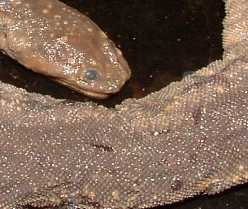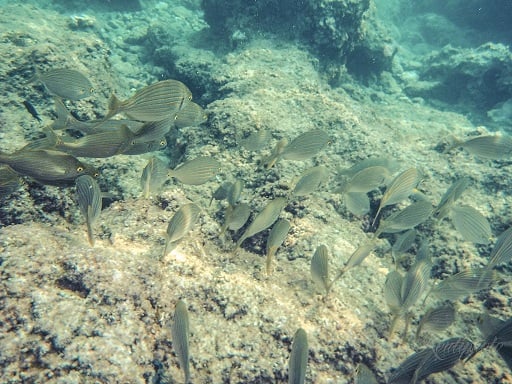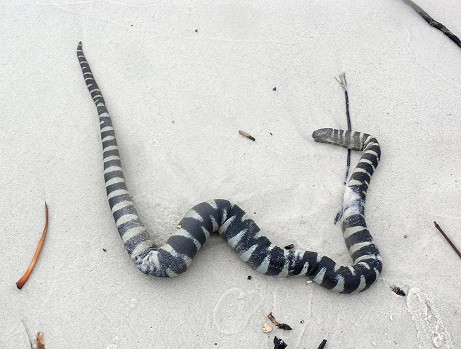| 1 | They look like an elephant trunk |

The elephant trunk snake is one of the strangest looking snakes found in the world today. It isn’t a terrifying, red-eyed devil snake, nor is it neon-coloured and obviously beautiful. Instead, the elephant trunk snake is unique for its baggy skin which almost hangs off its body.
This species is also known as the Javan filesnake and inhabits a swathe of Indopacific countries, particularly Indonesia and Malaysia. It’s primarily a water-dwelling snake, and over the ages, this habitat has slowly caused its skin to baggify, to increase its floating abilities and nimbleness in water. The skin barely fits the snake; some adults look as though they’ve stumbled across a fellow snake’s shed skin and stolen it.
Juvenile snakes can be different, as several youtube videos show elephant trunk snakes with colourful circular patterns with a yellow base of scales beneath. When they become adults, their skin darkens to grey, the bagginess increases, and the elephant picture is complete. The result is a mismatched, clumsy looking serpent which seems to have crawled inside an old pair of socks hidden inside a cobweb-infested broom cupboard.
| 2 | Dwells in secret Asian waters |
The elephant trunk snake spends almost all of its life underwater. It’s found on the shallow coastlines of seas, but never in the far flung depths of the sea, where strange glowing-eyed fish live and sunken treasures lie forever hidden. This snake nearly always sticks to depths of between 10 and 100 metres. Coastlines are fine for this snake, but the most common places to find them are streams, marshes, and estuaries, where fishermen often sail past in wooden boats. They’re at home in freshwater pools and brackish (saltwater) waters alike, and if you managed to snap a picture of the species, then it would most likely contain a grey head poking out of a river with some swampy green reeds in the background.
This watery world the species lives in is why its signature bagginess evolved in the first place. An elephant trunk snake not only has to live underwater, but swerve and strike at unsuspecting prey like a jack-in-the-box. The flipside is that their bagginess makes them poor at travelling on land, although not completely incapable. It’s more of a shuffle than a slither; they’ll stray onto land occasionally, but only when they truly have to. They’re effectively the opposite of humans.
| 3 | Species fact file |

The elephant trunk snake is a fairly long species, as the maximum length in females (which are larger than males) is 3 meters. The shape of its body is also unusual, as from the head, its body gradually thickens, growing significantly wider. At the tail, the body instantly contracts, creating a visibly separated tail which is also far shorter and sharper than the average snake’s. This tail is no more than half an inch wide.
Elephant trunk snakes are an ovoviviparous species, giving birth to live young, and the maximum births per session is said to be 52, with the average being 30. This is slightly above average for a snake, but their life cycle is exceptionally slow, as mothers only produce one group of neonates (baby snakes) every 8 years.
They also have some strange breeding powers, as one time, a captive elephant trunk snake gave birth to a single youngling over 7 years after it had been isolated from the rest of the snake kingdom (unless the males sneaked up the toilet).
| 4 | Perfectly tuned for underwater life |

As newborns, elephant trunk snakes spend significantly more time on land, as their signature bagginess hasn’t kicked in yet. As their skin loosens and loosens (which is probably confusing for them), the growing snakes are gradually pushed further and further into the water until the land become a much more hostile and forbidding place.
The body of this snake is perfectly tuned for being aquatic. Again, there’s the baggy scales, but its nostrils are also located on the top of its snout. The elephant trunk snake can spend 40 minutes underwater at once without its oxygen levels plummeting to zero. Afterwards, it’s forced to swim to the surface and breath for just 15-20 seconds in order to refill for the next 40 minute session, similarly to a dolphin. The location of the nostrils is perfect for this rapid manoeuvre. They’re similar to a boa constrictor’s nostrils, and in fact, the species’ skull shape is also similar to a boa, with a wide and flat head.
This species has extremely tiny scales, which are positioned adjacently, not overlapping at all. Each one is covered with a tiny sharp spike, like a collection of dark jewels. Each scale possess tiny sensory organs, to sense subtle movements in the water.
| 5 | Diet of an elephant trunk snake |

All this is perfectly designed for capturing the species’ main prey item: fish. The elephant trunk snake eats fish almost exclusively, and hunts them using a split strategy. In some cases, the species will use ambush strategies like an emerald tree boa, relaxing in the underground mud with a watchful eye, until a fish swims past and they spring to action. Other times, they’ll prowl around the shallow depths, but only ever at a glacial pace.
Once they’ve got the fish in their sights, the species will use another unique manoeuvre – grabbing the prey with its tail. Its tail is very short, but also “prehensile”, meaning that it’s capable of gripping things. The snake will then coil its entire body around the fish, so that a passing scuba diver would barely be able to see what’s inside. All the diver would see would be a floating ball of coiled snake, like an elephant’s trunk tied in a knot.
In the final manoeuvre, the elephant trunk snake rearranges its head, and swallows the captive fish whole. Sometimes it uses a different strategy, capturing the fish with their head first instead.
| 6 | Bagginess overload |

Once caught, a smaller fish has almost no chance of escaping this knot of doom. The endless rows of tiny, spiky scales are designed specifically for gripping the slipperiest, slimiest fish. Larger fish have a chance of escaping if the snake gets too cocky, but that’s when the snake’s backup strategy arrives: jamming its tail downwards into the mud in order to stabilise itself. The bagginess is another line of defence, as if a fish attempts to make an explosive dash for freedom, they’ll collide with the snake equivalent of an airbag instead.
Another rare feature created by the bagginess is that the snake’s mid-section doesn’t visibly swell after eating. There’s no animal-shaped lump; this is a snake which looks its trunk-like best at all times. Frogs are another entrant on their prey list sometimes, particularly when the snake dwells in swampy areas and marshes.
The elephant trunk snake has a shorter, yet thicker tongue than average, and while there are no poisonous fangs, this species is fully equipped with a double row of teeth. Its posteriormost teeth are also significantly sharper than the other two filesnake species.
| 7 | Legends from yore |
Things can go wrong with the elephant trunk’s diet as well. This blog captured an image of the closely related Acrochordus arafurae regurgitating an eel after a spike pierced its throat. Something similar happened to an American coachwhip once, which unwisely ate an extremely spiky horned lizard.
The elephant trunk snake was originally discovered by traveller Claës Hornstedy in 1787 who was accompanied on his quest by several Chinese people. The very first snake was a female measuring 8.2 feet. When they cut her open, they found 5 live young, ready to slither to freedom. They also found fruit in the snake’s stomach, which led to a long misconception that the species was frugivorous, a fruit-eater. This fruit was probably eaten by accident, in an unfortunate coincidence. Also strange was that this original snake was discovered in a plantation of pepper trees rather than water. The Chinese travellers later ate the snake, and reported it to be delicious.
Thankfully, the elephant trunk snake has no interest in eating members of the human race. Their teeth are venom-less, but it’s said that a bite is agonisingly painful, as their curved teeth often break off and remain embedded in the soft flesh.
| 8 | The species may be declining |
Although it’s possible that infected bite wounds have killed unrecorded Indonesian fisherman in the past, there are no officially recorded deaths from this species. It’s the opposite of an omnipresent terror: the species may be in decline.
Elephant trunk snakes are commonly hauled up from the water by fishermen, who remove their thick grey skins in order to make leather products. They then throw the remainder back into the water, wasting the other snake parts. According to ICUN, they’re still a “least concern” species, but reports are trickling out of Asia that sightings are becoming rare. In the 1980s, it was estimated that 2 million were exported from Indonesia annually, which probably put huge pressure on them given their glacial reproduction rates. The species’ leathery skin is so unique that few other snakes can substitute. It’s said that offerings on the international snake market are becoming increasingly rare.
As you can probably tell, the picture is murky and we can only rely on scraps of barely corroborated information. If they are endangered, then it’s probably cased by their preference for shallow water, as they’re unable to flee into deeper ocean territory like true sea snakes.
| 9 | There’s two closely related species |

The elephant trunk snake isn’t the only member of its family, as the Acrochordus family of snakes has 3 surviving members. The second species is the arfura filesnake, which has leathery, warty skin very similar to the elephant trunk. New Guinea tribesmen often hunt this species and skin it to make their traditional drums. This version also prefers shallow water, but has a specific tendency to bunch together beneath overhanging, tightly bundled tree roots along river shores.
Similar they may be, but there’s a clear dividing line between the two species: the Wallace line. The arfura filesnake lies to the east, inhabiting New Guinea and Australia, while the Javan filesnake (another name for the elephant trunk) lies to the west, and contains most of Indonesia, Malaysia, Thailand and Vietnam. The two species hardly ever interact.
The last member is the little filesnake, and this inhabits every combined territory of the other two. Its length is significantly smaller at 50-70cm, and its skin has stripy patterns instead, with a black and white colour. It’s the most adventurous of the 3 species, liking shallows waters but often appearing 10km out to sea.
It was only in 1979 that biologists realised that the arfura filesnake was actually a separate species to the elephant trunk snake.
| 10 | The prehistoric world |
Moving beyond the three filesnake/elephant trunk species, there’s a whole other ancient world: an extinct member of the family called achrochorus dehmi. This species lived 8-12 million years ago, and was most closely related to the elephant trunk snake of the surviving 3 species. This extinct species is a dream for palaeontologists because its natural habitats of shallow streams and estuaries, packed with mud, are perfect for fossil preservation.
Over 1000 fossils in over 100 different locations have been found of a. dehmi so far. Other acrochordus species have been discovered as well, including in modern day Nepal and Pakistan, as well as the current Indonesian range. Some were a monstrous 9 feet long, although there’s no saying whether its scales were grey and looked like an elephant trunk. There’s no proof that the bagginess had fully evolved yet either.
As a family, acrochordus has the most abundant fossil discoveries of any southeast Asian snake. Every fossil is dated from after the Indian continental plate crashed into the rest of Asia, so it’s possible that the species’ ancestors originated in India. Tellingly, no fossils of any acrochordus species have been found in Australia, which supports the theory neatly.
Saw a movie recently, talked about ” deadly venom of the Elephant snake ” and gave it an ability to kill in seconds, believe it was ” night of the strangler ” and used an Elephant snake because it’s easily and non dangerous to ” wrangle ” for effect…annoyingly miss informing to do such, but that’s 70’s Hollywood for you…